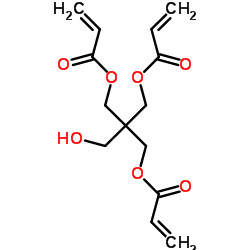Controlling poly(beta-amino ester) network properties through macromer branching.
Darren M Brey, Jamie L Ifkovits, Robert I Mozia, Josh S Katz, Jason A Burdick
文献索引:Acta Biomater. 4(2) , 207-17, (2008)
全文:HTML全文
摘要
Photopolymerizable and degradable biomaterials are becoming important in the development of advanced materials in the fields of tissue engineering, drug delivery, and microdevices. We have recently developed a library of poly(beta-amino ester)s (PBAEs) that form networks with a wide range of mechanical properties and degradation rates that are controlled by simple alterations in the macromer molecular weight or chemical structure. In this study, the influence of macromer branching on network properties was assessed by adding the trifunctional monomer pentaerythritol triacrylate (PETA) during synthesis. This led to a dose-dependent increase in the network compressive modulus, tensile modulus, and glass transition temperature, and a decrease in the network soluble fraction, yet led to only minor variations in degradation profiles and reaction behavior. For instance, the tensile modulus increased from 1.98+/-0.09MPa to 3.88+/-0.20MPa when the macromer went from a linear structure to a more branched structure with the addition of PETA. When osteoblast-like cells were grown on thin films, there was an increase in cell adhesion and spreading as the amount of PETA incorporated during synthesis increased. Towards tissue engineering applications, porous scaffolds were fabricated by photopolymerizing around a poragen and then subsequently leaching the poragen. Interconnected pores were observed in the scaffolds and observed trends translated to the porous scaffold (i.e., increasing mechanics with increasing branching). These findings demonstrate a simple variation during macromer synthesis that can be used to further tune the physical properties of scaffolds for given applications, particularly for candidates from the PBAE library.
相关化合物
| 结构式 | 名称/CAS号 | 分子式 | 全部文献 |
|---|---|---|---|
 |
季戊四醇三丙烯酸酯
CAS:3524-68-3 |
C14H18O7 |
|
In vitro and in vivo characterization of pentaerythritol tri...
2015-01-01 [Tissue Eng. Part A 21(1-2) , 320-31, (2015)] |
|
Novel highly hydrophilic methacrylate-based monolithic colum...
2011-07-22 [J. Chromatogr. A. 1218(29) , 4671-7, (2011)] |
|
Application and properties of butyl acrylate/pentaerythrite ...
2008-01-15 [Colloids Surf. B Biointerfaces 61(1) , 66-74, (2008)] |
|
Molecularly imprinted polymer of 5-methyluridine for solid-p...
2008-10-01 [Bioorg. Med. Chem. 16(19) , 8932-9, (2008)] |
|
Highly cross-linked networks for dental applications obtaine...
1999-02-01 [Acta Odontol. Scand. 57(1) , 1-8, (1999)] |